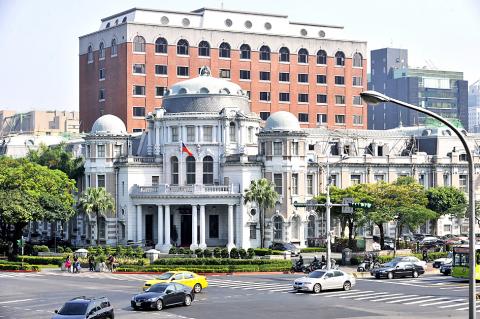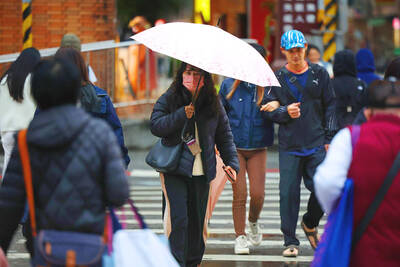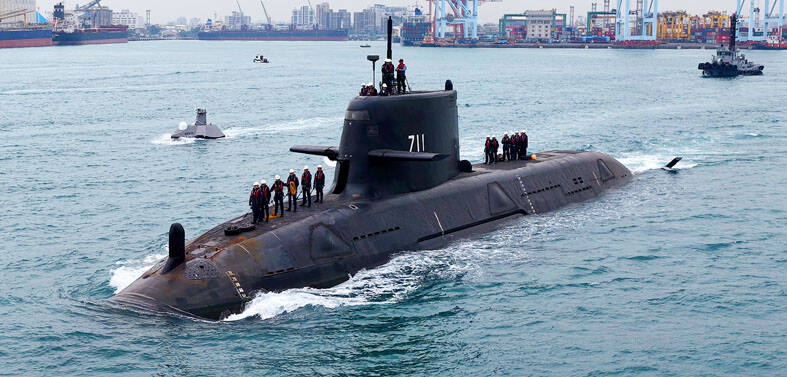The Control Yuan is to hold a series of activities in April to mark the centenary of its headquarters, described as a building of the grandiose baroque tradition.
For the occasion, Chunghwa Post is set to issue a commemorative stamp featuring the facade of the Control Yuan building, Control Yuan Secretary-General Fu Meng-jung (傅孟融) said, adding that the stamp is to be issued on April 24 — the building’s 100th anniversary.
Designed by Japanese architect Moriyama Matsunosuke, the two-story Control Yuan building was built in 1915 during the Japanese colonial era.

Photo: George Tsorng, Taipei Times
Japanese first used the building as the Taipei Prefecture Office, the headquarters for the northern counties of Taipei, Keelung and Yilan.
The building was later used to house the provincial special administration and the Taiwan Provincial Government, before it became the location of the Control Yuan in 1958.
On the building’s 100th anniversary, former Control Yuan leaders and members are to attend a ceremony, and a group of centenarians are to be taken on a tour of the building, Control Yuan Deputy Secretary-General Hsu Hai-chuan (許海泉) said.
The public will be able to visit an exhibition on the Control Yuan’s enforcement of its supervisory functions, including the findings of former Control Yuan member Huang Huang-hsiung’s (黃煌雄) 14-year investigation into the Chinese Nationalist Party’s (KMT) party assets, Hsu said.
The Control Yuan was rumored to have destroyed Huang’s findings, Hsu said, therefore it determined to make the report public to stem speculation.

SHIPS, TRAINS AND AUTOMOBILES: The ministry has announced changes to varied transportation industries taking effect soon, with a number of effects for passengers Beginning next month, the post office is canceling signature upon delivery and written inquiry services for international registered small packets in accordance with the new policy of the Universal Postal Union, the Ministry of Transportation and Communications said yesterday. The new policy does not apply to packets that are to be delivered to China, the ministry said. Senders of international registered small packets would receive a NT$10 rebate on postage if the packets are sent from Jan. 1 to March 31, it added. The ministry said that three other policies are also scheduled to take effect next month. International cruise ship operators

NUMBERS IMBALANCE: More than 4 million Taiwanese have visited China this year, while only about half a million Chinese have visited here Beijing has yet to respond to Taiwan’s requests for negotiation over matters related to the recovery of cross-strait tourism, the Tourism Administration said yesterday. Taiwan’s tourism authority issued the statement after Chinese-language daily the China Times reported yesterday that the government’s policy of banning group tours to China does not stop Taiwanese from visiting the country. As of October, more than 4.2 million had traveled to China this year, exceeding last year. Beijing estimated the number of Taiwanese tourists in China could reach 4.5 million this year. By contrast, only 500,000 Chinese tourists are expected in Taiwan, the report said. The report

Temperatures are forecast to drop steadily as a continental cold air mass moves across Taiwan, with some areas also likely to see heavy rainfall, the Central Weather Administration (CWA) said. From today through early tomorrow, a cold air mass would keep temperatures low across central and northern Taiwan, and the eastern half of Taiwan proper, with isolated brief showers forecast along Keelung’s north coast, Taipei and New Taipei City’s mountainous areas and eastern Taiwan, it said. Lows of 11°C to 15°C are forecast in central and northern Taiwan, Yilan County, and the outlying Kinmen and Lienchiang (Matsu) counties, and 14°C to 17°C

STEERING FAILURE: The first boat of its class is experiencing teething issues as it readies for acceptance by the navy, according to a recent story about rudder failure The Hai Kun (海鯤), the nation’s first locally built submarine, allegedly suffered a total failure of stern hydraulic systems during the second round of sea acceptance trials on June 26, and sailors were forced to manually operate the X-rudder to turn the submarine and return to port, news Web site Mirror Daily reported yesterday. The report said that tugboats following the Hai Kun assisted the submarine in avoiding collisions with other ships due to the X-rudder malfunctioning. At the time of the report, the submarine had completed its trials and was scheduled to begin diving and surfacing tests in shallow areas. The X-rudder,